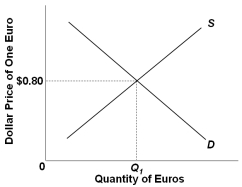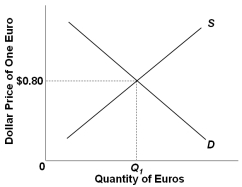Correct Answer

verified
Correct Answer
verified
Multiple Choice
The following diagram is a flexible exchange market for foreign currency:  Refer to the diagram.Other things equal,a leftward shift of the demand curve would:
Refer to the diagram.Other things equal,a leftward shift of the demand curve would:
A) depreciate the dollar.
B) appreciate the euro.
C) reduce the equilibrium quantity of euros.
D) cause a surplus of euros.
Correct Answer

verified
Correct Answer
verified
Multiple Choice
People who buy foreign currency for the sole goal of selling it at a profit are called:
A) numismatists.
B) currency hedgers.
C) currency manipulators.
D) currency speculators.
Correct Answer

verified
Correct Answer
verified
Multiple Choice
Which of the following would contribute to a U.S.balance of payments surplus?
A) The United States makes a unilateral tariff reduction on imported goods.
B) General Motors pays a dividend to a Swiss stockholder.
C) The United States cuts back on U.S.military personnel stationed in Germany.
D) Russian vodka becomes increasingly popular in the United States.
Correct Answer

verified
Correct Answer
verified
Multiple Choice
Which of the following problems will most likely occur with a system of flexible exchange rates?
A) Macroeconomic instability as exports and imports fluctuate with the exchange rates.
B) Government favoritism toward selected importers of goods and services.
C) The emergence of black markets for foreign currency.
D) Distortions in trade patterns away from the pattern suggested by comparative advantage.
Correct Answer

verified
Correct Answer
verified
Multiple Choice
In considering yen and dollars,when the dollar rate of exchange for the yen rises:
A) the yen rate of exchange for the dollar will fall.
B) the yen rate of exchange for the dollar will also rise.
C) the yen rate of exchange for the dollar may either fall or rise.
D) U.S.net exports to Japan will fall.
Correct Answer

verified
Correct Answer
verified
Multiple Choice
The U.S.demand for British pounds is:
A) downsloping because a higher dollar price of pounds means British goods are cheaper to Americans.
B) downsloping because a lower dollar price of pounds means British goods are more expensive to Americans.
C) upsloping because a lower dollar price of pounds means British goods are cheaper to Americans.
D) downsloping because a lower dollar price of pounds means British goods are cheaper to Americans.
Correct Answer

verified
Correct Answer
verified
Multiple Choice
Two of the implications of large U.S.trade deficits for the United States are:
A) decreased current consumption and decreased indebtedness to foreigners.
B) reduced budget deficits and decreased indebtedness to foreigners.
C) reduced current consumption and higher saving.
D) increased current consumption and increased indebtedness to foreigners.
Correct Answer

verified
Correct Answer
verified
Multiple Choice
In recent years,the United States has had large:
A) current account surpluses.
B) capital and financial account deficits.
C) balance of trade deficits.
D) balance of payments surpluses.
Correct Answer

verified
Correct Answer
verified
Multiple Choice
Answer the question on the basis of the following 2012 balance of payments data (+ and -) for the hypothetical nation of Zabella.All figures are in billions of dollars. Refer to the given data.Zabella's balance on financial account shows a:
A) deficit of $10 billion.
B) surplus of $5 billion.
C) deficit of $28 billion.
D) surplus of $13 billion.
Correct Answer

verified
Correct Answer
verified
Multiple Choice
The following diagram is a flexible exchange market for foreign currency:  Refer to the diagram.At the price $.80 for 1 euro:
Refer to the diagram.At the price $.80 for 1 euro:
A) the quantity of euros demanded equals the quantity supplied.
B) the dollar-euro exchange rate is unstable.
C) the dollar price of 1 euro equals the euro price of 1 dollar.
D) there will be a surplus of euros in the foreign exchange market.
Correct Answer

verified
Correct Answer
verified
Multiple Choice
A market in which the money of one nation is exchanged for the money of another nation is a:
A) resource market.
B) bond market.
C) stock market.
D) foreign exchange market.
Correct Answer

verified
Correct Answer
verified
Multiple Choice
A government may be able to reduce the international value of its currency by:
A) selling its currency in the foreign exchange market.
B) buying its currency in the foreign exchange market.
C) selling foreign currencies in the foreign exchange market.
D) increasing its domestic interest rates.
Correct Answer

verified
Correct Answer
verified
Multiple Choice
Suppose the balance on the financial account is -$300 billion and the balance on the capital account is +$5 billion.The size of the current account is:
A) +$295 billion.
B) -$295 billion.
C) +$305 billion.
D) +$5 billion.
Correct Answer

verified
Correct Answer
verified
True/False
Answer the question on the basis of the following 2008 balance of payments statement for Transylvania.All figures are in billions of dollars. Refer to the given data.Transylvania had a $2 billion balance of trade (goods)surplus in 2008.
Correct Answer

verified
Correct Answer
verified
Multiple Choice
Which of the following has contributed to large U.S.trade deficits in recent years?
A) China fixing its exchange rate.
B) Rapid decreases in the price of oil that have triggered dramatic increases in oil imports.
C) A rising U.S.saving rate.
D) All of these have contributed.
Correct Answer

verified
Correct Answer
verified
Multiple Choice
If the equilibrium exchange rate changes so that fewer dollars are needed to buy a South Korean won,then:
A) Americans will buy fewer Korean goods and services.
B) the won has appreciated in value.
C) fewer U.S.goods and services will be demanded by the South Koreans.
D) the dollar has depreciated in value.
Correct Answer

verified
Correct Answer
verified
True/False
The United States has had significant trade and current account surpluses in recent years.
Correct Answer

verified
Correct Answer
verified
Multiple Choice
Which of the following is not included in the current account of a nation's balance of payments?
A) Its goods exports.
B) Its goods imports.
C) Its net investment income.
D) Its purchases of real assets abroad.
Correct Answer

verified
Correct Answer
verified
Multiple Choice
The following table contains hypothetical data for the 2012 U.S.balance of payments.Answer the question on the basis of this information.All figures are in billions of dollars. Refer to the given data.The United States has a balance of goods:
A) deficit of $10 billion.
B) surplus of $30 billion.
C) deficit of $30 billion.
D) surplus of $20 billion.
Correct Answer

verified
Correct Answer
verified
Showing 61 - 80 of 138
Related Exams